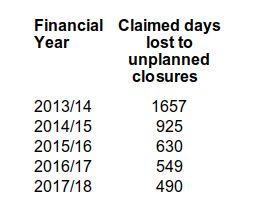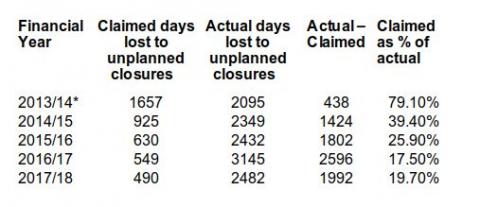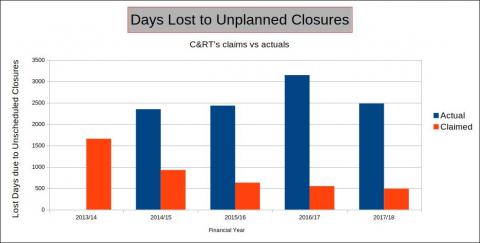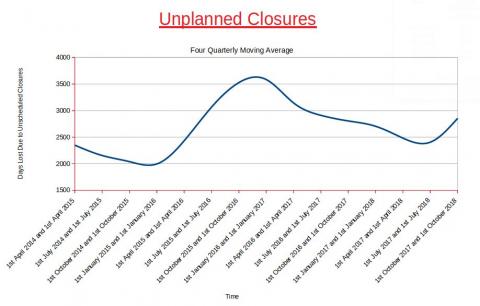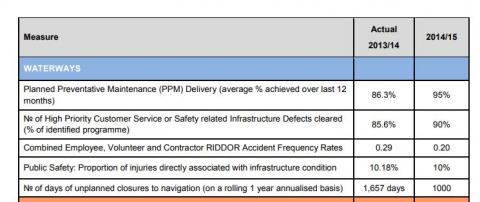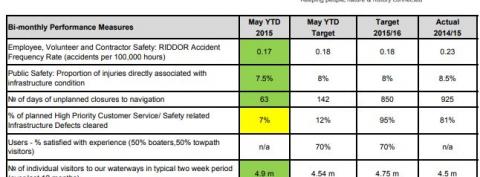Does C&RT board know the real number of emergency closures?
October 2018 -
In September The Floater disputed a claim made in Canal & River Trust's annual report, presented to the public a few days ago, regarding unscheduled closures of its waterways. Now we have further evidence that unscheduled closures are rising - not falling as the report suggests.
With Canal and River Trust’s head of legal services [Tom Deards] claiming that answering questions about closures would cause: “harassment of, or distress to, the public authorities staff', Allan Richards found a way to interrogate the C&RT stoppage database and get historical closure information.
Allan said 'Whilst it is thought that, with some effort, the program could be adapted in future to split ‘navigation closures’ into ‘planned’ and ‘emergency’, as an interim it has been used produce closure figures for the six months between May and October each year when the vast majority of closures are ‘emergency’ (i.e. outside the winter works period).'
Allan has now rewritten his program such that it can distinguish between emergency (also known as unplanned or unscheduled) closures and planned closures (often but not exclusively due to 'winter works'). Allan has also investigated C&RT's claim by reference to historical documents.
Let's dive straight in with C&RT's claim made on page 15 of its latest annual report -
‘Notwithstanding our rising core expenditure and our improving application of the principles of long term asset management as our asset strategy evolves, the considerable age of our infrastructure, much over two centuries old, means that we do suffer significant asset failures that require immediate intervention. Lock 15 on the Peak Forest Canal’s Marple flight had to be closed in September 2017 after a lock wall was found to have moved such that the lock had become un-usable. This was a significant factor in us missing our target on unplanned closures in the year, (with 490 days lost against the target of 400, though this remains a significant improvement since the Trust was created).'
Cutting to the chase, C&RT claim 'this remains a significant improvement since the Trust was created'.
On the right are the unplanned closure days figures on which C&RT is basing its claim -
The figures form one of Canal & River Trust's Key Performance Indicators (KPI's) with the last three also being given in annual reports. Early each financial year chief executive, Richard Parry, presents a list of suggested KPI's together with targets for board approval. As can be seen from the above quote, last year (2017/18) C&RT missed its target of 400 days of unplanned closures but attempted to put a positive spin on this failure by claiming that it has reduced unplanned closures since its formation.
Not true!
Allan's amended program takes as its input C&RT's claimed figures for each financial year comparing them with with the information stored on C&RT's stoppage database. In summary, it gives the following -
(*Note - The program reported that data held on C&RT's stoppage database for 2013/14 was incomplete. As such 'actual days lost' represents only the data found which will be less than the true figure. The reason for giving the figure in the above table is that it demonstrates that C&RT was under reporting 'days lost' to its board that year).
C&RT's under reporting of days lost can be shown graphically (see right). -
Notes:
1. The high figure for 2016/17 is probably due to flooding. However, no work has been done to quantify this.
2. As C&RT's company year begins April 1, the 2017/18 figures do not include days lost due to lack of water resources during this summer.
3. An 'actual' figure for 2013/14 is not provided (see above).
As can be seen, C&RT's claim that the situation regarding emergency closures (aka unplanned or unscheduled closures) has improved since it was formed is completely untrue. In fact, 'days lost to closure' has increased.
To give a better picture of the rising trend in days lost, a four quarterly moving average chart has been produced which smooths out the chart above. It also enables data for the first half of C&RT's 2018/19 financial year to be incorporated -
One point to note from the above is that that the number of days lost from the start to the end of the graph is about 400 (i.e. 'days lost' rises from 2400 to 2800). The second point is that the low points are also 400 'days lost' apart (2000 and 2400). This suggests that 'days lost' is rising about 5% per year.
Having, hopefully convinced that C&RT has been dramatically under reporting unplanned closures for years, we will now turn to what the board was actually told. Apologies if what follows is rather long-winded but it is thought necessary to document how C&RT's board has been given inaccurate figures regarding the state of our waterways.
Here is the first example (see right). It is taken from a document presented by Richard Parry to his board in July 2015. As can be seen the board was informed that 1657 days were lost to unplanned closures in 2013/14. Despite this, Mr Parry was suggesting that C&RT would be able to reduce that to 1000 in 2014/15. Note that the board was informed that the measure being used was 'No of days of unplanned closures to navigation'. Note also that the figure of 1,657 days is lower than the incomplete data on C&RT's stoppage database (2,095).
A year later (see right) the board of Trustees were told by its chief executive that C&RT had reduced the figure to 925 thus beating the 1,000 target (smaller is better in this case!). Note also that Mr Parry was still telling the board that the measure was 'No of days of unplanned closures to navigation'. Unfortunately, C&RT's stoppage database shows 2,349 'lost days' for this year. The figure he provided to the board appears to be less than 40% of the true figure.
Having under reported unplanned closures two years running, it seems that a decision was made to bring the figures down further by altering the way in which they were measured. Instead of continuing with 'No of days of unplanned closure', a perfectly reasonable measure, C&RT's board were told that two new measures were being introduced. Henceforth, C&RT would measure itself on 'No of days of unplanned closures to navigation within our control (individual instances over 4 hours)' and 'No of days of unplanned closures to navigation within our control (individual instances over 48 hours)'.
The first of the above was dropped after a year. The final screenshot (below) shows the target of 400 that C&RT set themselves for 2017/18 having achieved reduced 'lost days' to 441 the previous year.
To sum up, in the first two years under review, the numbers suggest Richard Parry under reported the number of days lost to unplanned closures. This was made worse by changing the way the figures were reported to 'Number of days of unplanned navigation closures within our control (individual instances over 48hrs) (2017/18)'.
This change has allowed C&RT to exclude short term closures and, more importantly gave them the flexibility to exclude closures as being 'beyond our control'.
Perhaps this explains why C&RT is so willing to place the blame for emergency closures on anyone but themselves - some favourites are vandals, boaters and the weather. Last year they excluded 80% of closures as 'beyond our control'!
Take for example, the Middlewich breach. C&RT started off by initially suggesting that the breach was caused by a boater or vandal opening head and tail gates on the locks above and below the breach sites. That of course, is impossible due to water pressure and, even if it could be achieved any resulting breach would occur downstream of the locks not between them. Since then the story has changed somewhat with C&RT still failing to provide an engineering report into the cause of the catastrophe.
So how was C&RT's Board given the wrong figures for so many years? The fact is that C&RT's board appears to have little interest in maintaining its waterways. This can be demonstrated by its its various committees -
Audit and Risk Committee
Investment Committee
Appointments Committee
Nominations Committee
Remuneration Committee
Despite claiming that it spent £131.9 million on maintaining its waterways last year, C&RT's board of Trustees has no Navigation Committee. It has never had a Navigation Committee. Even if it did, who would be members of that committee? Indeed, most of the Trustees waterways connections and experience seem to be tenuous, to say the least.
Sadly, lack of relevant experience and focus at board level is allowing our waterways to deteriorate at an alarming level. Here is one boater asking, chief executive, Richard Parry why he should not cancel his Friends subscription -
'My wife and I have been boat owners since 2004, with all attendant costs and responsibilities this brings.Whilst also tax payers, we wished to contribute further to the canal system we call home for nine months each year, and so joined the Friends scheme, and thus make an additional financial contribution each month.
'However we are becoming increasingly disillusioned with the inept management and lack of routine maintenance of the canal system.Our experience this year has been a litany of leaking lock walls, gates and canal beds, rotting and broken balance beams and paddle gear, and unmaintained lift and swing bridges. It is apparent that little or no work is undertaken until a total failure of the infrastructure in question occurs.
'I am moved to write finally by discovering that our usual coal and diesel boat is unable to reach us on the lowest point of the Grand Union canal (please note lowest, not summit) as the water levels in the Long Itchington pound and down Bascote locks is much too low for a laden working boat to navigate.This despite ongoing water level issues in that pound for at least two years.
'If C&RT are not there to ensure these hard working boaters can go about their business, may I ask what exactly are you there for?
'I am seeking some indication or direction from you as to why we should not cancel our Friends commitment.
'At present we feel slightly foolish that we continue to make a voluntary financial donation to an organisation which appears incapable of spending money wisely, and targeted towards its main purpose for existing.
'We are not by nature 'negative' people, and truly look for the good and positive. Every single member of C&RT bankside staff we have met have been helpful, supportive and fine ambassadors for the trust, but equally all have been very depressed by the direction the trust has taken in recent years, and express fear for the future.
'I look forward to some meaningful response from you. I am not exploding with happiness or making life better by water at present and seek some indication that we are not forgotten.'
Perhaps he should have copied C&RT's seemingly oblivious chair, Allan Leighton?
Read the earlier article here: C&RT's canal closure figures don't hold water
Photos: (1st) Unplanned closure days figures, (2nd) Their summary, (3rd) C&RT's under reporting of days lost, (4th) Four quarterly moving average chart, (5th) Document presented by Richard Parry to his board in July 2015, (6th) A year later, (7th) Days of unplanned closures to navigation within our control, (8th) Target of 400 that C&RT set themselves for 2017/18.






